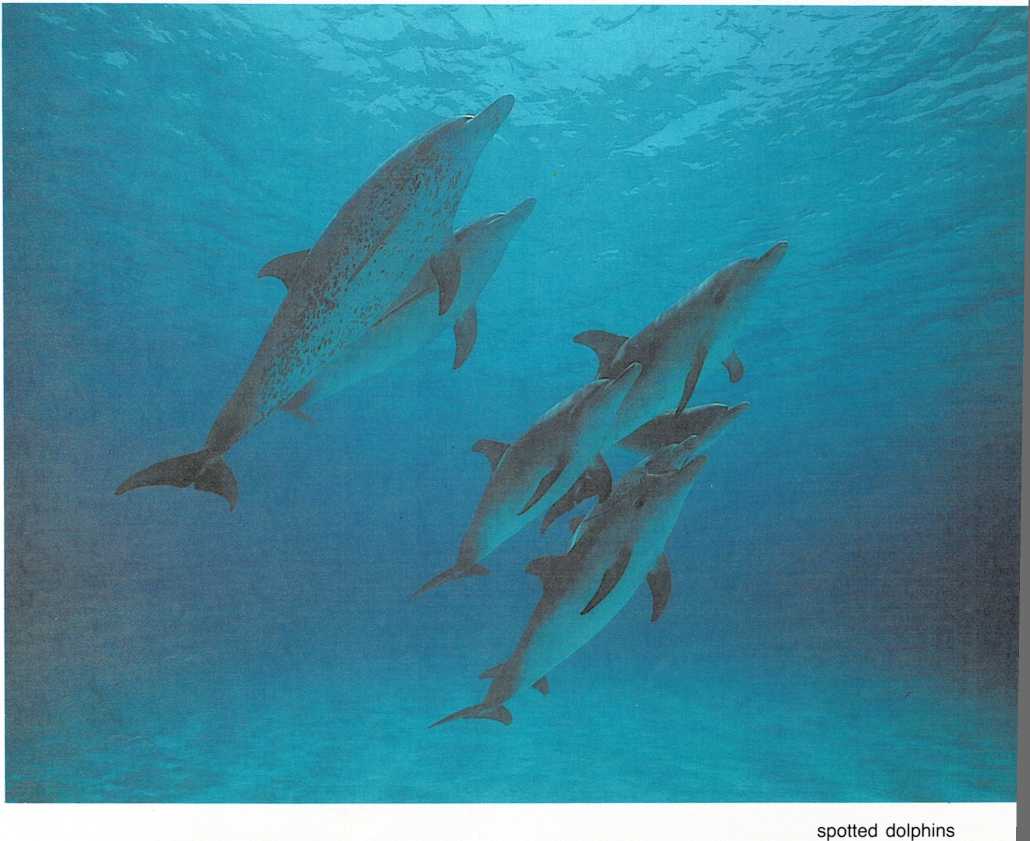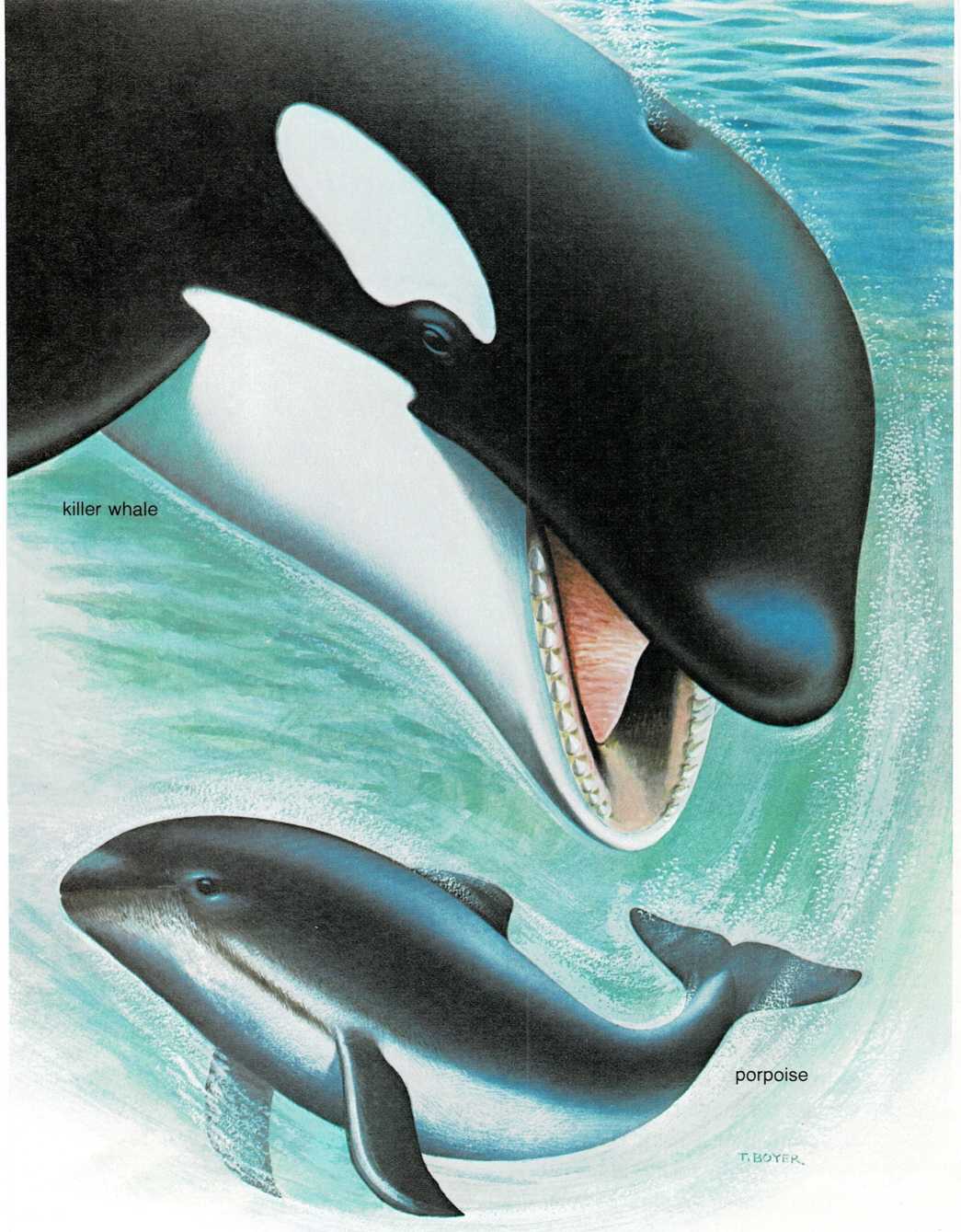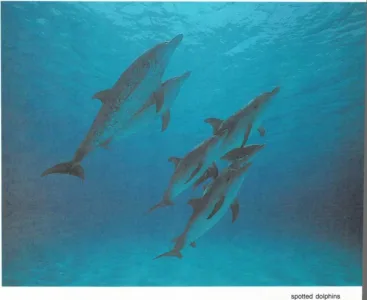Dolphins and porpoises
The dolphin [(dahl]{.smallcaps} fuhn) and the porpoise
[(pawhr]{.smallcaps} puhs) are really small whales. Both belong to the
large group of whales called toothed whales.
Most people can’t tell a dolphin from a porpoise. But there is an easy
way to tell them apart. The snout of a dolphin forms a stubby, rounded
beak. A porpoise does not have a beak. Also, dolphins are much more
playful than porpoises. They often leap up out of the water, which
porpoises seldom do.
There are seven kinds of porpoises. All are smaller than most dolphins.
The common porpoise is about five feet (1.5 m) long. Porpoises live in
all parts of the world and eat mostly fish.
There are about thirty kinds of dolphins. The best-known is the
bottle-nosed dolphin. It is more than eight feet (2.4 meters) long, with
a gray body and a rounded forehead. Its beaked mouth seems to be always
smiling.
Bottle-nosed dolphins are smart and are easily trained to do tricks.
They often put on shows at aquariums and zoos. A bottle-nosed dolphin
named Flipper was once the star of a television series.
Bottle-nosed dolphins live in all parts of the world, usually in coastal
waters. They eat mostly small fish.
The common dolphin is especially well liked by sailors. Schools of these
dolphins often follow ships. For hundreds of years, sailors have
believed that they are a sign of a happy voyage. The animals actually
seem to enjoy putting on a show. They will dive in and out

of the water and even “dance” on the surface on their tail fins.
Common dolphins are about seven feet (2.1 m) long, with black or
dark-gray backs and white undersides. They live in warm parts of the
ocean and eat mostly fish.
Another kind of dolphin is called Risso’s dolphin. It is about thirteen
feet (4 m) long. Unlike their relatives, Risso’s dolphins don’t have
much of a beak. They eat mostly squid and cuttlefish, rather than fish.
One Risso’s dolphin became quite famous.

For twenty-four years, this dolphin escorted ships through Pelorus
Sound, near New Zealand. A favorite with travelers, it became known as
\”Pelorus Jack.”
One kind of dolphin—the killer whale—has a bad reputation. Killer
whales are big creatures, as much as thirty feet (9 m) long, with a
black back and a white underside.
They live in groups in all parts of the ocean.
Until a very short time ago, it was believed that killer whales were
vicious, bloodthirsty beasts that would attack and eat anything— even
people! Now we know that killer whales eat mostly fish and squid,
although they will also eat dolphins, porpoises, and small seals.
Scientists have also found that killer whales are very intelligent
animals. They can be tamed, and will even do tricks, like other
dolphins. They really don’t deserve their name or their bad reputation!
Dolphins can make a number of different sounds, such as squeaks,
whistles, clicks, and quacks. They do this by blowing air out of the
blowhole, or nostril, on top of the head. The dolphins communicate with
each other by means of these sounds. A young dolphin that has been
separated from its mother will make a noise that brings her hurrying to
it.
Scientists think that dolphins can also make sounds that imitate human
speech. However, they \”speak” so rapidly, and with such high sounds,
that it is difficult to understand them. But dolphins are so intelligent
that some scientists think they can be taught how to really talk with
people—not just imitate the sounds of words, as a parrot does, but
actually hold conversations!
The sea animals you’ll read about on the next few pages aren’t related
to one another. They belong to different groups of animals.
One group that you may know is the sponges. Sponges all belong to one
big \”family” called poriferans (paw RIHF uhr uhnz). The name means
\”having holes.” Sponges are strange creatures that look more like
plants than animals. For a long time, people thought they were plants!
Another group is made up of creatures called sea squirts. Their
scientific name is tunicates [(too]{.smallcaps} nuh kihts), which means
\”dressed in a tunic.” A tunic is a short gown or coat. And the small,
odd-looking tunicates do have a thick, leathery coat of skin.
The third group is made up of worms. There are a great many kinds of
worms in the sea. Some are like land worms, but others are very
different. There isn’t just one \”family” of worms. There are a number
of different families.
Poriferans, tunicates, and worms play an important part in the life of
the sea.

